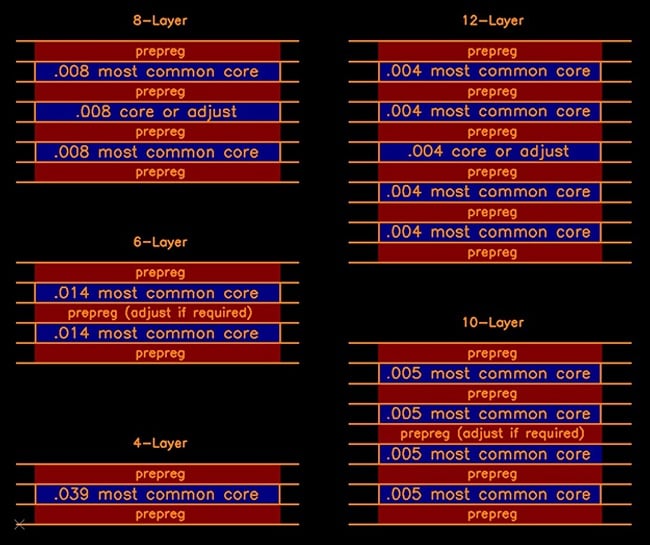Selecting PCB core thickness becomes a problem when a printed circuit board (PCB) fabricator receives a request for quotation of a multilayer design and the material requirements are stated either incompletely or not at all. This sometimes occurs because the combination of PCB core materials used is not critical to performance; if the overall thickness requirement is met, the end user may not care about the thickness or type of each layer.
At other times, however, performance is more important, and thickness needs to be controlled tightly for the board to function at its best. If the PCB designer communicates all requirements clearly in the documentation, the fabricator will understand what is required and will set up the materials accordingly.
What PCB Designers Need to Consider
It helps designers to understand what materials are available and commonly stocked, so they can use appropriate design rules for their PCBs to be built quickly and correctly. What follows is a brief explanation of which material types fabricators like to work with and what they are likely to have on hand for quick turn work so that your project will not be delayed.
Understanding PCB Laminate Cost and Stocking
It is important to understand that PCB laminate material is sold in and works in “systems” and that the core and prepreg materials that a manufacturer keeps in stock for immediate use are typically all from the same system. In other words, the constituent elements are all parts of one particular product, with a few variations such as thickness, copper weight, and prepreg style. Beyond familiarity and repeatability, there are some other reasons for stocking a limited range of laminate types.
Systems of prepregs and cores are formulated to work together, but they will not necessarily work correctly when used in combination with another product. For example, one would not use Isola 370HR core material in the same stack as Nelco 4000-13 prepreg. It is possible that they might work together in some situations, but it is far more likely that they will not. Mixing systems takes you into uncharted territory, where the behavior of the materials – known when used as a homogeneous system – can no longer be taken for granted. There have been spectacular failures from careless or uninformed mixing and matching material types, so no fabricator will mix and match unless the types are proven to be appropriate for use in “hybrid” stack-ups.

Complex RF Hybrid PCB design with internal pockets
Another reason for maintaining a narrow material inventory is that UL certification is costly, so limiting the number of certifications to a relatively small selection of materials is common in the PCB industry. Fabricators will often agree to build product on a laminate they don’t stock as standard, but with the caveat that they cannot supply UL certifications with their QC documentation. This is fine for non-UL designs if it is disclosed and agreed upon ahead of time and if the fabricator is familiar with the processing requirements of the laminate system in question. For UL work, it is best to find out what your chosen fabricator stocks and design your boards to match.
IPC-4101D and Foil Construction
Now that these facts are out in the open, there are two other things to understand before jumping into a design. First, it is best whenever possible to specify your laminate per the industry specification IPC-4101D, rather than by naming one particular product which not everybody will stock.
Second, multilayers are easiest to build using the “foil” construction method. Foil construction means that the top and bottom (external) layers are made from a sheet of copper foil, laminated to the rest of the layers with prepreg. While it seems intuitive that an 8-layer PCB would be built with four double-sided cores, it is much preferred to use foil externally, then to use three cores for L2-L3, L4-L5, and L6-L7. In other words, plan to design your multilayer stack-up so that your number of cores will be as follows: (Total number of layers minus 2) divided by 2. Next it is useful to know a few things about the characteristics of the cores themselves.
Cores are supplied as a sheet of fully-cured FR4, with copper cladding on both sides. The cores come in a range of thicknesses, with the more commonly used sizes typically stocked in greater inventory quantities. These are the thicknesses you will want to keep in mind, particularly when you need to order a quick turnaround so that no lead time for the order will be wasted waiting for non-standard material to arrive from a distributor.
Common Core and Copper Thicknesses
The core thicknesses which are most commonly used for construction of 0.062” thick multilayers are 0.005”, 0.008”, 0.014”, 0.021, 0.028”, and 0.039”. It is also fairly common for 0.047” to be in stock, because it is sometimes used for building 2-layer boards. Another core that will always be stocked is 0.059” because it is used to produce 0.062”-thick 2-layer boards, but it would only be used in thicker multilayers, such as 0.093”. For the purposes of this post, we will limit the scope to cores appropriate for use in designs with a final nominal thickness of 0.062”.

Examples of PCB core thicknesses
Copper thickness can range from half-ounce to 3 or 4 ounces, depending upon the specific fabricator’s product mix, but most of the inventory is likely to be 2oz or less. Keep this in mind, and keep in mind that almost all the stock will use the same copper weight on both sides of the core. Try to avoid designing your PCB to require different copper on each side because that will generally require a special purchase, with possible premium charges applied for rush delivery and in some cases for not meeting a distributor’s minimum order quantity.
For example, if you feel that you wish to use 1oz copper for your planes and have been planning to use H-ounce for signals, consider either making the planes H-ounce or increasing the signals to 1oz so that the cores will be used like copper weights on both sides. Of course, you can only do this if you are still able to meet the design’s electrical requirements and if you have enough XY area available to accommodate widening the trace/space design rules to meet 1oz minimum values on the signal layers. If you are able to meet these criteria, it is best to use like copper weights. Otherwise, you may need to factor in a couple of extra days’ delivery time.
Assuming you have selected appropriate core thicknesses with available copper weights, the remaining dielectric positions are built up using various combinations of prepreg sheets until the required overall thickness requirement is met. For designs which do not require impedance control, you may leave prepreg selection up to your fabricator; they will use their preferred “standard” build. If, on the other hand, you do have impedance requirements, state these in your documentation so that the fabricator can adjust the amount of prepreg between the cores to meet the stated values.
Impedance Control
Whether or not impedance control is required, it is not recommended that you attempt to call out each position’s prepreg type and thickness in your documentation unless you are well-versed in doing so. Generally, stack-ups that are detailed to such a degree end up needing adjustment, so they can cause delays. Instead, your stack-up diagram can show the core thicknesses for the internal layer pairs, with the prepreg positions called out “as needed to meet impedance and overall thickness requirements.” This allows the fabricator to create an ideal stack-up which will match your design.
Summary
An ideal stack-up, based on cores that are already in stock, is essential for avoiding needless delays when you order a time-critical quick turn. Most PCB manufacturers use similar multilayer constructions based on the same cores as their competitors; unless the PCB is highly customized, there are no magic or secret constructions. It is therefore worthwhile to familiarize yourself with the materials which are preferred for specific layer counts and to make every effort to design your PCB to match. There will always be exceptions with unusual design requirements, but in general, standard materials are your best bet.
Key Takeaways
- Understanding PCB laminate systems is crucial: Core and prepreg materials should come from the same system to ensure compatibility and avoid manufacturing issues.
- Stocked materials impact lead times: Choosing commonly available core thicknesses and copper weights reduces delays, as special orders may require extra processing time and costs.
- Foil construction simplifies multilayer PCB fabrication: Using external foil layers with internal cores instead of all double-sided cores leads to easier and more reliable PCB manufacturing.
- Consistent copper weights on both sides of a core help reduce costs: Mismatched copper weights can require special material purchases, increasing lead times and expenses.
- Prepreg selection is best left to the fabricator for impedance: Specifying only the core thickness and overall board thickness allows manufacturers to optimize the stack-up for performance and manufacturability.

















